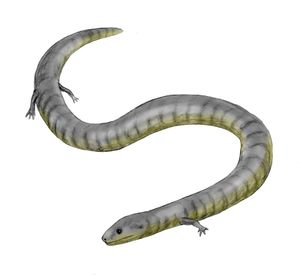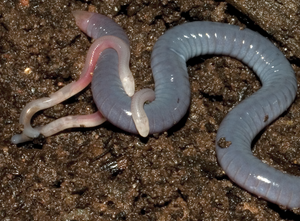ضفدع ثعباني
| ضفدع ثعباني | |
|---|---|

| |
| Oscaecilia ochrocephala (عديمات الأرجل) | |
| التصنيف العلمي | |
| أصنوفة غير معروفة (أصلحها): | الحياة |
| مملكة: | الحيوانية |
| Phylum: | حبليات |
| فرع حيوي: | برمائيات ملساء |
| Order: | الضفادع الثعبانية مولر، 1832[1] |
| تحت مجموعات | |
| |
| Synonyms[1] | |
| |
الضفادع الثعبانية (Caecilians، /sɪˈsɪliən/؛ اللاتينية الحديثة for 'العمياء')، هي مجموعة من البرمائيات عديمة الأطراف، دودية الشكل أو ثعبانية الشكل، ذات عيون صغيرة أو معدومة أحياناً. تعيش غالباً مختبئة في التربة أو مجاري الأنهار، وهذا النمط من الحياة الغامض يجعل الضفادع الثعبانية من أقل البرمائيات شيوعاً. تعيش الضفادع الثعبانية الحديثة في المناطق الاستوائية في أمريكا الجنوبية، أمريكا الوسطى، أفريقيا، وجنوب آسيا. تتغذى الضفادع الثعبانية على كائنات جوفية صغيرة مثل ديدان الأرض. جسمها أسطواني الشكل، وغالباً ما يكون داكن اللون، وجمجمتها ذات بنية قوية وعلى شكل رصاصة. تتميز رؤوس الضفادع الثعبانية بتكيفات فريدة عديدة، منها اندماج عظام الجمجمة والفك، ونظام عضلات الفك المكون من جزأين، ومجس كيميائي أمام العين. جلدها لزج ويحمل علامات أو أخاديد حلقية، وقد يحتوي على قشور.[2]
الوصف

تشريح الضفادع الثعبانية مُكيّف للغاية مع نمط حياة الحفر. في نوعين من تلك التي تنتمي إلى الجنس البدائي Ichthyophis، عُثر على آثار بقايا أطراف، وفي Typhlonectes compressicauda لُوحظ وجود براعم أطراف أثناء التطور الجنيني، وهي بقايا مندثرة في جسمٍ كان خالياً تماماً من الأطراف.[3] يجعل هذا الأنواع الأصغر من الضفادع الثعبانية تشبه الديدان، بينما الأنواع الأكبر مثل 'Caecilia thompsoni، التي يصل طولها إلى متر ونصف، تشبه الثعابين. ذيولها قصيرة أو غير موجودة، ومجرى البول الخاص بها يقع بالقرب من أطراف أجسامها.[4][5][6]
الجمجمة والحواس

الجلد

إنتاج الحليب
كما هو موثق في مجلة ساينس سلطت الأبحاث الحديثة الضوء على سلوك أنواع معينة من الضفادع الثعبانية. تكشف هذه الدراسات أن بعض الضفادع الثعبانية تُظهر ظاهرة تُزود فيها صغارها بمادة غنية بالمغذيات تُشبه الحليب، تُوصلها عبر فتحة أمومية. من بين الأنواع التي خضعت للدراسة، برز الضفدع الثعباني البيوض-غير الثديي Siphonops annulatus، مما يُشير إلى أن ممارسة الرضاعة قد تكون أكثر انتشاراً بين هذه المخلوقات مما كان يُعتقد سابقاً. وكما هو مُفصّل في دراسة أجريت عام 2024، جمع الباحثون 16 أماً من نوع Siphonops annulatus من مزارع الكاكاو في غابة الأطلسي البرازيلية، وصوّرواهن مع صغارهن في المختبر. بقيت الأمهات مع صغارهن، الذين كانوا يرضعون سائل أبيض لزج من المذرق، وشهدوا نمواً سريعاً في أسبوعهم الأول. تُنتج هذه المادة الشبيهة بالحليب، والغنية بالدهون والكربوهيدرات، في غدد قناة البيض الطلائية المتضخمة لدى الأم، والتي تشبه حليب الثدييات.
أُطلقت المادة، على ما يبدو، استجابةً للتحفيز اللمسي والصوتي من الصغار. لاحظ الباحثون أن الصغار تُصدر أصوات طقطقة عالية النبرة عند اقترابها من أمهاتها لأخذ الحليب، وهو سلوك فريد بين البرمائيات. قد يُسهم هذا السلوك في نمو ميكروبيوم الصغار وجهازهم المناعي، على غرار صغار الثدييات. يشير وجود إنتاج الحليب لدى الضفادع الثعبانية التي تضع البيض إلى انتقال تطوري بين وضع البيض والولادة.[7][8][9]
الانتشار
تعيش الضفادع الثعبانية في المناطق الاستوائية الرطبة في جنوب شرق آسيا، الهند، بنگلادش، نيپال [10] وسريلانكا، وأجزاء من شرق وغرب أفريقيا، وجزر سيشل في المحيط الهندي، وأمريكا الوسطى، وفي شمال وشرق أمريكا الجنوبية. في أفريقيا، تنتشر الضفادع الثعبانية من غينيا بيساو إلى جنوب ملاوي، وهناك سجل غير مؤكد من شرق زيمبابوي. لم تُسجل في المناطق الشاسعة من الغابات الاستوائية بوسط أفريقيا. في أمريكا الجنوبية، تمتد عبر شرق البرازيل شبه الاستوائي إلى شمال الأرجنتين المعتدل. يمكن رؤيتها جنوباً حتى بوينس آيرس، عندما تحملها مياه فيضان نهر پارانا القادمة من أقصى الشمال. يمتد نطاقها الأمريكي شمالاً إلى جنوب المكسيك. انتشارها في أقصى الشمال يتضمن Ichthyophis sikkimensis في شمال الهند. يوجد أيضاً Ichthyophis في جنوب الصين وشمال ڤيتنام. في جنوب شرق آسيا، تنتشر شرقاً حتى جاوة وبورنيو وجنوب الفلپين، لكنها لم تعبر خط والاس وليست موجودة في أستراليا أو الجزر القريبة. لا يوجد ضفادع ثعبانية في مدغشقر، وكن وجودها في سيشل والهند أدى إلى تكهنات حول وجود ضفادع ثعبانية منقرضة أو موجودة هناك.[11]
عام 2021، جُمعت عينة حية من Typhlonectes natans، وهو ضفدع ثعباني موطنه كولومبي وڤنزويلا، من قناة تصريف في جنوب فلوريدا. كان هذا الضفدع الثعباني الوحيد الذي سُجِّل في البرية بالولايات المتحدة، ويُعتبر نوعاً مستقدماً، ربما من تجارة الحياة البرية. لا يُعرف ما إذا كان قد تأسس تجمع تكاثري في المنطقة.[12][13]
التصنيف
| الفصيلة | صورة | صاحب الأصنوفة | الجنس | النوع | الاسم الشائع | النطاق الجغرافي |
|---|---|---|---|---|---|---|
| Caeciliidae |  Caecilia subnigricans |
رافينسك، 1814 | 2 | 47 | الضفادع الثعبانية الشائعة | أمريكا الوسطى والجنوبية (بوليڤيا شمالاً إلى كوستاريكا). |
| Chikilidae | كامي وزملائه، 2012 | 1 | 4 | الضفادع الثعبانية الهندية الشمالية | شمال شرق الهند وبنگلادش، مع تواجد محتمل في بورما. | |
| Dermophiidae |  Geotrypetes seraphini |
تايلور، 1969 | 4 | 15 | الضفادع الثعبانية الإستوائية الجديدة | أفريقيا الإستوائية (غرب أفريقيا، تنزانيا، كينيا)، أمريكا الوسطى والجنوبية (كولومبيا شمالاً إلى المكسيك). |
| Grandisoniidae (formerly Indotyphlidae) |  Grandisonia sechellensis |
لوسكور، رينو وگاسك، 1986 | 7 | 24 | الضفادع الثعبانية الأفريقية الهندية | أفريقيا الإستوائية (الكاميرون، إثيوپيا)، سيشل، غرب الهند (الغات الغربية). |
| Herpelidae |  Boulengerula taitana |
لوران، 1984 | 2 | 10 | الضفادع الثعبانية الأفريقية | أفريقيا الاستوائية (نيجيريا جنوباً إلى جمهورية الكونغو الديمقراطية، وكينيا جنوباً إلى ملاوي، ومناطق محتملة في أنگولا وزامبيا). |
| Ichthyophiidae |  Ichthyophis kodaguensis |
تايلور، 1969 | 2 | 57 | الضفادع الثعبانية المذيلة الآسيوية | جنوب وجنوب شرق آسيا (غرب الهند شمالاً إلى نيپال، وشرقاً إلى الفلپين، وجنوباً إلى الصين وإندونيسيا). |
| Rhinatrematidae |  Epicrionops sp. |
نوسبوم، 1977 | 3 | 14 | الضفادع الثعبانية المذيلة الأمريكية | شمال أمريكا الجنوبية (أقصى شمال البرازيل غرباً إلى ڤنزويلا، وكولومبيا، والإكوادور، وپيرو). |
| Scolecomorphidae |  Scolecomorphus kirkii |
تايلور، 1969 | 2 | 6 | الضفادع الثعبانية مدفونة الأعين | أفريقيا الاستوائية (الكاميرون، تنزانيا، ملاوي، موزمبيق). |
| Siphonopidae |  Microcaecilia dermatophaga |
بوناپرت، 1850 | 5 | 28 | الضفادع الثعبانية الأمريكية الجنوبية | أمريكا الجنوبية (كولومبيا جنوباً إلى شمال الأرجنتين، پاراگواي، وأقصى جنوب البرازيل). |
| Typhlonectidae | Typhlonectes natans |
تايلور، 1968 | 5 | 14 | الضفادع الثعبانية المائية | أمريكا الجنوبية (كولومبيا وڤنزويلا جنوباً إلى شمال الأرجنتين وأوروگواي). |
| Gymnophiona |
| |||||||||||||||||||||||||||||||||||||||||||||||||||||||||||||||||||||||||||||||||||||||||||||||||||||||||||||||||||||||||||||||||||||||||||||||||||||||||||||||||||||||||||||||||
التطور

السلوك
التكاثر
النظام الغذائي
الأهمية الثقافية
انظر أيضاً
مرئيات
| دودة الضفدع الثعباني ترضع صغارها بمادة تشبه الحليب. |
المصادر
- ^ أ ب Frost, Darrel R. (2019). "Gymnophiona Müller, 1832". Amphibian Species of the World: an Online Reference. Version 6.0. American Museum of Natural History. Retrieved 11 September 2019.
- ^ Wilkinson, Mark (2012). "Caecilians" (PDF). Current Biology. 22 (17): R668–R669. Bibcode:2012CBio...22.R668W. doi:10.1016/j.cub.2012.06.019. PMID 22974987.
- ^ An Anatomical Feature of Caecilian Amphibians: The Lengthening of the Body and Organs
- ^ Goin, C. J.; Goin, O.B.; Zug, G.W. (1978). "Order Gymnophiona". Introduction to Herpetology (3rd ed.). San Francisco: W.H. Freeman and Company. p. 201. ISBN 978-0-7167-0020-3.
- ^ Himstedt, Werner (1996). Die Blindwühlen (in الألمانية). Magdeburg: Westarp Wissenschaften. ISBN 978-3-89432-434-6.
- ^ خطأ استشهاد: وسم
<ref>غير صحيح؛ لا نص تم توفيره للمراجع المسماةBrittanica - ^ Quaglia, Sofia (2024-03-07). "Bizarre, Wormlike and Oozing Milk for Their Babies". The New York Times (in الإنجليزية الأمريكية). ISSN 0362-4331. Retrieved 2024-03-11.
- ^ Wake, Marvalee H. (7 Mar 2024). "Amphibian hatchlings find mother's milk". Science (in الإنجليزية). 383 (1060-1061 (2024)): 1060–1061. Bibcode:2024Sci...383.1060W. doi:10.1126/science.ado2094. PMID 38452095.
{{cite journal}}: Check|pmid=value (help) - ^ Mailho-Fontana, Pedro L.; Antoniazzi, Marta M.; Coelho, Guilherme R.; Pimenta, Daniel C.; Fernandes, Lígia P.; Kupfer, Alexander; Brodie, Edmund D.; Jared, Carlos (2024-03-08). "Milk provisioning in oviparous caecilian amphibians". Science (in الإنجليزية). 383 (6687): 1092–1095. Bibcode:2024Sci...383.1092M. doi:10.1126/science.adi5379. ISSN 0036-8075. PMID 38452082.
{{cite journal}}: Check|pmid=value (help) - ^ Rathor, Hariharsingh (5 May 2016). "Kutnjema Mareka Jiv Sarpa Hoina". Katipur. Kantipur News. Archived from the original on 22 February 2017. Retrieved 5 May 2016.
- ^ James D. Gardner, Jean-Claude Rage, The fossil record of lissamphibians from Africa, Madagascar, and the Arabian Plate, Palaeobiodiversity and Palaeoenvironments 96(1):1-52 · March 2016
- ^ "Worm-Like, Limbless Amphibian Known As Caecilians Spotted in Florida For The First Time". Conservation.Reefcause.com (in الإنجليزية الأمريكية). 2021-08-03. Retrieved 2021-08-04.
- ^ Sheehy, Coleman; Blackburn, David; Kouete, Marcel; Gestring, Kelly; Laurie, Kristin; Prechtel, Austin; Suarez, Eric; Talley, Brooke (2021-07-15). "First record of a caecilian (order Gymnophiona, Typhlonectes natans) in Florida and in the United States". Reptiles & Amphibians (in الإنجليزية). 28 (2): 355–357. doi:10.17161/randa.v28i2.15629. ISSN 2332-4961.
وصلات خارجية
 Media related to Gymnophiona at Wikimedia Commons
Media related to Gymnophiona at Wikimedia Commons Information related to Gymnophiona from Wikispecies.
Information related to Gymnophiona from Wikispecies.
- CS1 الألمانية-language sources (de)
- CS1 الإنجليزية الأمريكية-language sources (en-us)
- CS1 errors: PMID
- Short description matches Wikidata
- Automatic taxobox cleanup
- Pages with Langnf omitting second positional parameter
- ضفادع ثعبانية
- Gymnophiona
- برمائيات الحقبة الوسطى
- Hettangian first appearances
- Extant Early Jurassic first appearances
- أصنوفات أسماها يوهانس پيتر مولر



